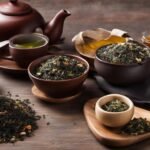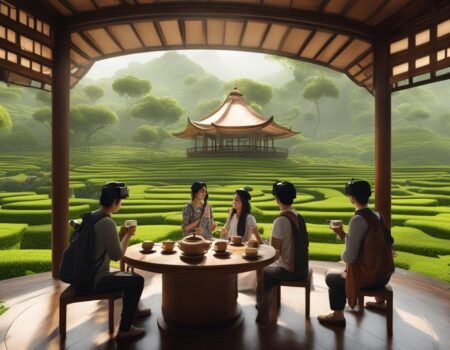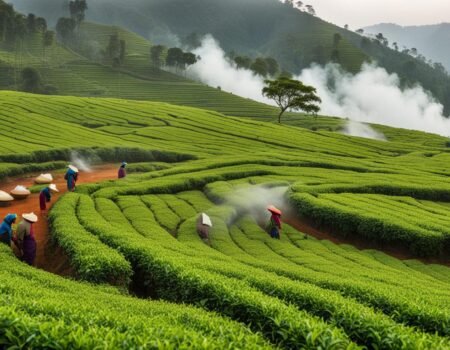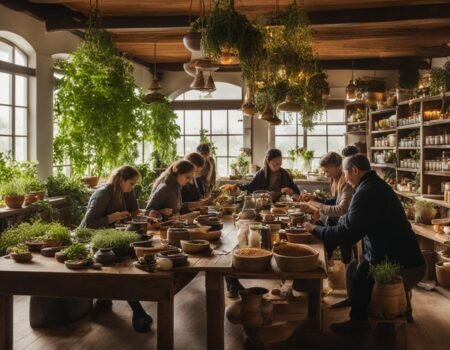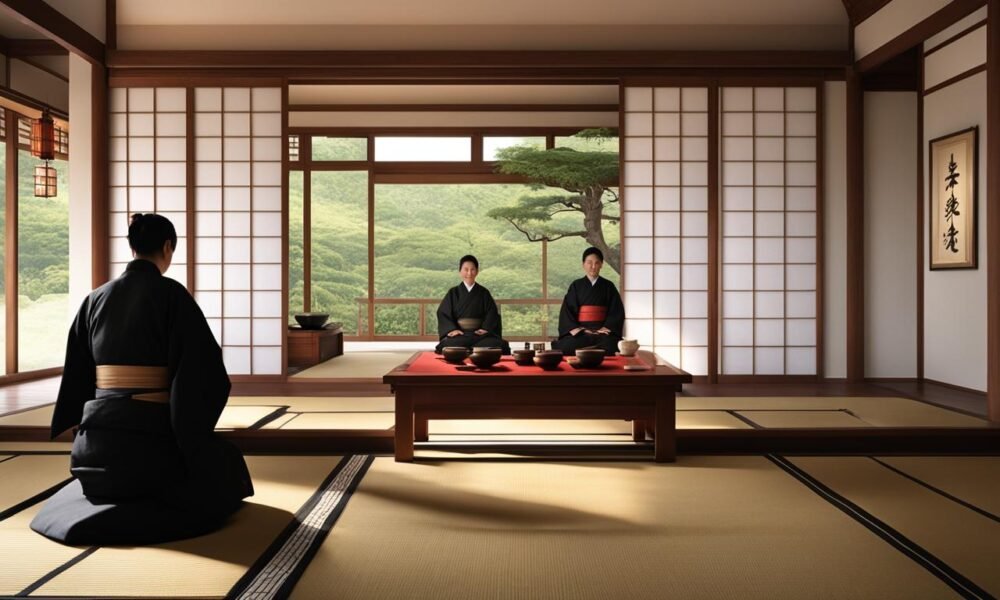
Comparative Analysis: Japanese vs. Chinese Tea Ceremonies
Welcome to our in-depth exploration of the fascinating world of Japanese and Chinese tea ceremonies. In this article, we will take you on a journey to compare these two captivating traditions and uncover the cultural differences that make them unique. So grab a cup of your favorite tea and let’s dive in!
Key Takeaways:
- Japanese and Chinese tea ceremonies are strikingly different in style and cultural influences.
- Chinese tea culture is characterized by a focus on nature, pleasure, and harmony.
- Japanese tea culture, influenced by Zen thought, emphasizes solemnness, introspection, and imbalance.
- Both traditions share a common appreciation for the artistry and ingenuity of tea-making.
- The atmosphere of Japanese tea ceremonies is serene and meditative, while Chinese tea ceremonies are lively and accompanied by conversation.
Origins and Development of Tea Culture in China and Japan
Tea culture in China and Japan has deep roots that have been shaped by centuries of history and cultural influences. Understanding the origins and development of tea culture in these two countries provides valuable insights into the aesthetic characteristics that define their respective tea ceremonies.
In ancient China, tea was an integral part of daily life and was deeply intertwined with the country’s social, philosophical, and religious traditions. The Chinese tea culture originated under the influence of Confucianism, Buddhism, and Taoism, which emphasized the importance of harmony with nature and the pursuit of inner peace. Tea became a medium for fostering spiritual growth and social connections, with tea ceremonies evolving as a formalized way to appreciate and share this beloved beverage.
Japan, being a neighboring country and influenced by China, adopted tea culture after the introduction of Zen ideology. The Japanese tea ceremony, known as “chanoyu” or “sado,” was developed by combining Zen thought with native Japanese cultural practices. The tea ceremony became a way to cultivate mindfulness, simplicity, and tranquility. It also served as a means for socializing and fostering bonds between individuals, reflecting the principles of harmony and respect deeply ingrained in Japanese society.
“The tea ceremony is a way to bring people together, fostering connections and appreciating the beauty of simplicity.”
– Anonymous
The evolution of tea culture in both China and Japan showcases the distinct aesthetic characteristics that define their respective tea ceremonies. Chinese tea culture is characterized by its connection to nature, pleasure, and harmony, with a focus on finding beauty in the natural elements of the environment and deriving pleasure from the tea-drinking experience. In contrast, Japanese tea culture, influenced by Zen thought, embodies qualities of solemnness, introspection, and imbalance, emphasizing a serene and meditative atmosphere during the tea ceremony.
Aesthetic Characteristics of Chinese Tea Culture:
- Nature-inspired aesthetics
- Focus on pleasure and appreciation
- Emphasis on harmony and balance
Aesthetic Characteristics of Japanese Tea Culture:
- Simplicity and tranquility
- Reflective and introspective ambiance
- Imbalance as a source of beauty
These aesthetic characteristics shape the overall atmosphere and experience of the tea ceremonies, creating distinct cultural traditions that have captivated tea enthusiasts around the world.
Table: A Comparison of Chinese and Japanese Tea Culture
| Aspect | Chinese Tea Culture | Japanese Tea Culture |
|---|---|---|
| Aesthetic Characteristics | Nature-inspired, pleasure-focused, harmonious | Simplicity, tranquility, imbalance |
| Social Significance | Fosters connection and socializing | Cultivates mindfulness and introspection |
| Philosophical Influences | Confucianism, Buddhism, Taoism | Zen Buddhism |
Aesthetic Characteristics of Chinese Tea Culture
Chinese tea culture is a reflection of the nation’s deep appreciation for nature, pleasure, and harmony. It is a celebration of the beauty found in the natural elements that surround us and an invitation to find joy in every sip of tea. The aesthetic characteristics of Chinese tea culture are rooted in centuries-old traditions and beliefs, shaping an experience that is both visually captivating and spiritually uplifting.
In Chinese tea culture, nature is the ultimate source of inspiration. The tea ceremony takes place in serene and picturesque settings, often in lush gardens or tranquil spaces that harmonize with the surroundings. The emphasis on the natural environment is reflected in the choice of materials, such as clay teapots and bamboo tea utensils, which are believed to enhance the flavors and aromas of the tea.
Aesthetic pleasure is another cornerstone of Chinese tea culture. From the delicate aroma of the tea leaves to the exquisite craftsmanship of the teaware, every aspect of the tea-drinking experience is designed to evoke a sense of beauty and delight. The tea itself is carefully selected and brewed with precision, ensuring that every cup is a sensory journey that delights the palate and nourishes the soul.
Harmony is at the heart of Chinese tea culture’s aesthetic characteristics. It is a celebration of balance and unity, both in the tea ceremony itself and in the broader context of life. The tea master strives to create a harmonious atmosphere, where every movement and gesture is imbued with grace and elegance. The tea ceremony becomes a meditative practice, a moment of tranquility and connection with oneself and the natural world.
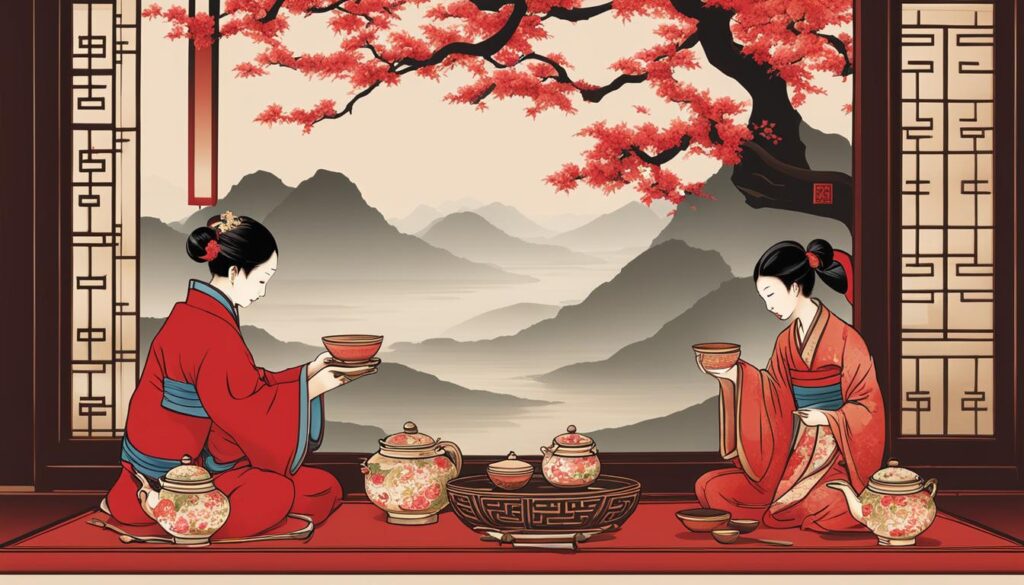
The Serenity of Chinese Tea Culture
“In the silence of a tea garden, I find serenity and solace. The gentle breeze whispers secrets of the leaves, and the warm cup of tea comforts my weary soul.” – Anonymous
Chinese tea culture offers a glimpse into a world where nature, pleasure, and harmony intertwine to create a truly extraordinary experience. It invites us to slow down, savor the moment, and appreciate the beauty that surrounds us. Through the aesthetic qualities of Chinese tea culture, we are reminded of the profound connection between humans and the natural world, and the endless possibilities that arise when we embrace simplicity, joy, and balance.
Table: Aesthetic Characteristics of Chinese Tea Culture
| Aesthetic Characteristics | Description |
|---|---|
| Nature | Rooted in the appreciation of the natural environment |
| Pleasure | Focus on creating a delightful sensory experience |
| Harmony | Celebration of balance and unity in the tea ceremony |
Aesthetic Characteristics of Japanese Tea Culture
Japanese tea culture, deeply influenced by Zen thought, embodies unique aesthetic characteristics that set it apart from other tea ceremonies. The emphasis is on creating a sense of solemnness and introspection, evoking a feeling of tranquility and mindfulness during the tea ceremony. This distinctive approach reflects the Japanese appreciation for simplicity and the beauty of imperfection.
One key aesthetic characteristic of Japanese tea culture is solemnness. The tea ceremony is conducted with utmost seriousness and reverence, creating an atmosphere of deep respect for the tea, the utensils, and the participants. It is a time for quiet contemplation and introspection, allowing individuals to connect with their inner selves and find peace in the present moment. The serene ambiance and deliberate movements during the ceremony contribute to the overall solemnness of the experience.
Another notable characteristic is loneliness. Unlike the lively and sociable nature of some tea ceremonies, Japanese tea culture embraces solitude and cherishes moments of self-reflection. The tea ceremony is often performed in a small, intimate setting, with the host and guests sharing a deep connection through the act of tea drinking. This sense of loneliness allows individuals to focus on their own thoughts and emotions, fostering a sense of inner calm and self-awareness.
The aesthetic of imbalance is also integral to Japanese tea culture. It reflects the concept of wabi-sabi, which appreciates the beauty of imperfection and transience. The asymmetrical arrangement of tea utensils and the deliberate placement of imperfectly crafted tea bowls highlight the transient nature of life and the acceptance of imperfections. This emphasis on imbalance adds a sense of depth and authenticity to the tea ceremony, making it a truly unique and soulful experience.
In conclusion, the aesthetic characteristics of Japanese tea culture, influenced by Zen thought, highlight the value placed on solemnness, loneliness, and imbalance. This distinctive approach creates a serene and introspective atmosphere, inviting individuals to find tranquility within themselves and embrace the beauty of imperfection. Japanese tea culture is a testament to the profound connection between mindfulness and aesthetics, enriching the tea-drinking experience in a truly meaningful way.
Similarities in Japanese and Chinese Tea Ceremonies
When it comes to Japanese and Chinese tea ceremonies, there are several fascinating similarities that underscore the shared appreciation for tea and the artistry involved in its preparation. Despite the distinct cultural characteristics of each ceremony, both traditions value the creation of delicious and visually beautiful tea, showcasing the ingenuity and craftsmanship of the tea masters.
In both the Japanese and Chinese tea ceremonies, the focus is not solely on the act of drinking tea but rather on the entire experience surrounding it. Both cultures emphasize the importance of creating a serene and captivating ambiance during the ceremony, with meticulous attention given to every detail from the preparation of the tea to the choice of utensils.
While the Japanese tea ceremony emphasizes simplicity and quietness, the Chinese tea ceremony is characterized by a lively and interactive atmosphere. In both traditions, guests are encouraged to appreciate the aesthetics of the tea presentation, including the color, fragrance, and appearance of the tea. The process of brewing and serving the tea becomes an art form in itself, with the tea masters showcasing their skills and expertise.
| Similarities in Japanese and Chinese Tea Ceremonies | |
|---|---|
| Japanese Tea Ceremony | Chinese Tea Ceremony |
| The emphasis on simplicity and quietness | A lively and interactive atmosphere |
| Meticulous attention to detail | Appreciation of aesthetics |
| Tea is prepared and served as an art form | Ingenuity and craftsmanship of tea masters |
“In both Japanese and Chinese tea ceremonies, the act of making and serving tea is an art form in itself, showcasing the skill and creativity of the tea masters.”
The shared love for tasty and beautiful tea is a testament to the cultural value placed on this ancient beverage. Whether it’s the solemn and introspective ambiance of the Japanese tea ceremony or the lively and convivial atmosphere of the Chinese tea ceremony, both traditions exemplify the rich cultural heritage of East Asia.
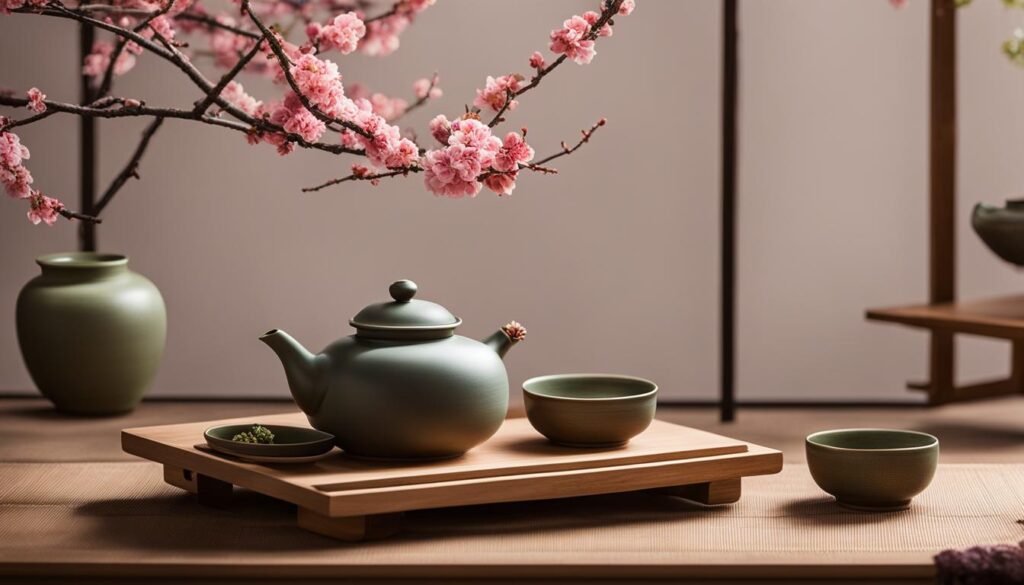
Delighting the Senses with Tea
- Both ceremonies focus on the taste, aroma, and visual appeal of the tea.
- The utensils used in the ceremonies are meticulously chosen for their aesthetic qualities.
- The tea masters demonstrate their skills in brewing and serving tea, captivating the guests’ senses.
Cultural Exchange
The similarities between Japanese and Chinese tea ceremonies also reflect the historical exchange of ideas and culture between the two countries. The original tea culture of Japan was heavily influenced by China, with the introduction of Zen Buddhism playing a significant role in shaping the Japanese tea ceremony. Over time, however, both cultures have developed their unique styles, incorporating their own artistic sensibilities and cultural nuances.
The appreciation and reverence for tea have transcended borders, uniting people from different cultures and backgrounds. The similarities in Japanese and Chinese tea ceremonies serve as a testament to the universal appeal and enduring legacy of this beloved beverage.
Differences between Japanese and Chinese Tea Ceremonies
In examining the differences between Japanese and Chinese tea ceremonies, we uncover contrasting aesthetic characteristics, atmospheres, and approaches. The Japanese tea ceremony emphasizes simplicity and quietness, creating a serene and meditative ambiance. On the other hand, the Chinese tea ceremony is lively and often accompanied by cheerful conversations, reflecting the vivacious nature of Chinese culture.
Japanese tea ceremonies are known for their minimalistic and refined presentation. Every gesture and movement in the ceremony is deliberate and precise, highlighting the beauty of simplicity. The focus is on creating a tranquil environment that allows participants to fully immerse themselves in the moment.
“The Japanese tea ceremony is a dance between the host and the guests, a moment of pure stillness and harmony.”
Conversely, the Chinese tea ceremony is characterized by a lively atmosphere and animated conversations. It is a social event where friends and family gather to enjoy tea, share stories, and engage in lively discussions. The emphasis is on fostering connections and creating a convivial atmosphere.
These differences in atmosphere and approach reflect the contrasting national characters of Japan and China. While the Japanese value tranquility and introspection, the Chinese prioritize social interactions and liveliness. Both tea ceremonies have their unique charm, offering a glimpse into the cultural nuances of these two nations.
Table: Contrasting Elements of Japanese and Chinese Tea Ceremonies
| Japanese Tea Ceremony | Chinese Tea Ceremony |
|---|---|
| Emphasizes simplicity and quietness | Characterized by liveliness and animated conversations |
| Focuses on creating a serene and meditative ambiance | Encourages social interactions and lively discussions |
| Deliberate and precise gestures and movements | Casual and relaxed atmosphere |
| Values introspection and self-reflection | Prioritizes social connections and shared experiences |
The contrasting elements of Japanese and Chinese tea ceremonies offer fascinating insights into the cultural diversity of East Asia. While simplicity and quietness define the Japanese tea ceremony, liveliness and social interactions dominate the Chinese tea ceremony. These distinct characteristics reflect the deep-rooted cultural values and traditions of these two countries.
Conclusion
In our cross-cultural tea ceremony analysis, we have explored the rich traditions and practices of tea ceremonies in Japan and China. The tea ceremony traditions in these two countries are truly fascinating, each reflecting the unique cultural heritage and values of their respective nations.
Throughout our exploration, we have discovered the distinct aesthetic characteristics that shape Japanese and Chinese tea culture. The Japanese tea ceremony, influenced by Zen thought, embodies solemnness, loneliness, and imbalance, creating a serene and introspective atmosphere. On the other hand, the Chinese tea ceremony focuses on nature, pleasure, and harmony, with its lively and vibrant ambiance accompanied by cheerful conversations.
While both cultures share a deep appreciation for the art of tea-making, they differ in their overall approach and atmosphere. The Japanese tea ceremony emphasizes simplicity and quietness, allowing for a meditative experience. In contrast, the Chinese tea ceremony embraces liveliness and encourages social interactions through friendly conversations.
By comparing these two tea ceremony traditions, we gain valuable insights into the cultural nuances and practices that define Japan and China. The tea ceremonies serve as windows into the rich histories and values of these East Asian nations, providing not only a sensory experience but also an opportunity to connect with their profound cultural heritage.
FAQ
What are the origins of Chinese tea culture?
Chinese tea culture originated in ancient China, where tea was considered one of the essential elements of daily life. It was influenced by Confucianism, Buddhism, and Taoism, which shaped a unique and long-standing Chinese tea culture.
How did Japanese tea culture develop?
Japan adopted tea culture from China after the introduction of Zen ideology. The Japanese tea ceremony culture developed by combining Zen thought and native Japanese culture.
What are the aesthetic characteristics of Chinese tea culture?
Chinese tea culture focuses on finding beauty in the natural elements of the environment and deriving pleasure from the tea-drinking experience. Harmony is also an important aspect, emphasizing the balance between different elements in the tea ceremony.
What are the aesthetic characteristics of Japanese tea culture?
Japanese tea culture embodies characteristics such as solemnness, loneliness, and imbalance. The emphasis is on creating a serene and introspective atmosphere during the tea ceremony, reflecting the principles of Zen Buddhism.
Do Japanese and Chinese tea ceremonies share any similarities?
Yes, both Japanese and Chinese tea ceremonies value the ingenuity and craftsmanship involved in the tea-making process. They both appreciate the art of making tea tasty and beautiful.
How do Japanese and Chinese tea ceremonies differ in atmosphere?
The Japanese tea ceremony is known for its simplicity and quietness, creating a serene and meditative ambiance. In contrast, the Chinese tea ceremony is lively and often accompanied by cheerful conversations.

